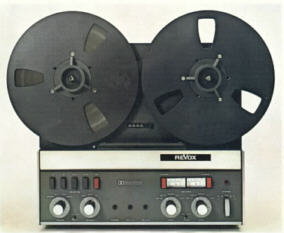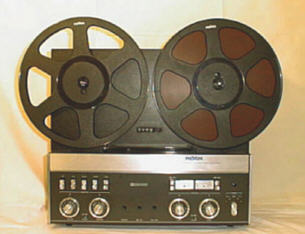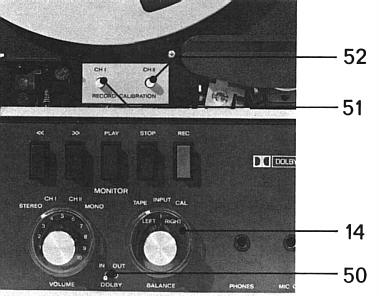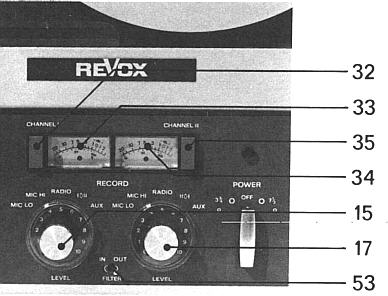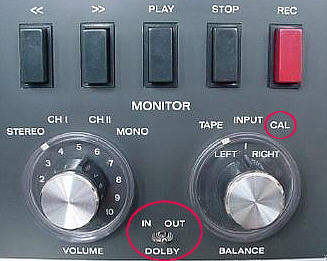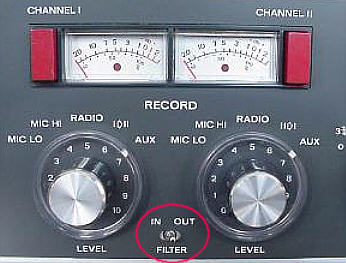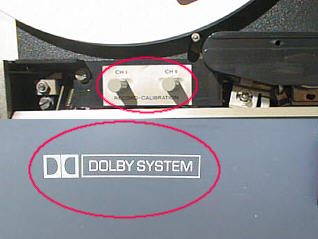Operating Instructions for the REVOX A77
equipped with DOLBY B Noise Reduction System
|
|
A77 MK III Dolby A77 MK IV Dolby |
|
Compared with the Standard version, the A77 tape recorder with DOLBY B electronics features a few additional operating controls. The following instructions are with reference to the
additional operations required when utilizing the DOLBY noise reduction system. (Dolby is a registrated trade mark)Before
switching your recorder on, please read carefully the instructions ( brief operating instructions ) for the standard model, while also paying attention to the designations used for the operating controls as shown in the illustrations an the following pages. All other index numbers make reference to the operating instructions for the standard version except for the following changes:|
Standard Recorder |
DOLBY Version |
||
|
SPEAKERS OFF (41) |
omitted |
||
|
REEL MOTORS OFF (42) |
omitted |
||
|
Monitor selector (14): |
|
||
|
- Position NAB |
corresponds to TAPE |
||
|
- Position IEC |
replaced by Calibrate ( new function ) |
||
|
|
|
|
|
|
Index Numbers 50 DOLBY IN/OUTSwitch to activate or to deactivate the DOLBY noise reduction circuits. |
|
. 51 Record Calibration for Channel I52 Record Calibration for Channel II53 FILTER IN/OUTSwitch for turning the multiplex filter an or off. |
|
1. Operation without DOLBY- Electronics

2. Recording DOLBY Encoded tapes
Signal to Noise Ratio of the Sound Source
Equal Level Requirement for Record and Playback
The DOLBY noise reduction System operates with a dynamic filter whose characteristics are determined by the constantly varying sound levels. To ensure a playback performance which is an exact mirror image of the record process, it is absolutely essential that the record and playback levels are equal. This is achieved by a special gain calibrating circuit ( record calibration ) which enables the Operator to compensate for differences in sensitivity between different tape oxides ( or even between batch differences of the same oxide).
3. Record Calibration (prior to recording)
1. Switch the recorder on by selecting tape speed and reel size. Load recorder with tape.
2. Put DOLBY electronics into circuit by flicking switch 50 into position IN.
3. Close record level controls 15 and 17 by turning them fully anticlockwise.
4. Press channel selector buttons 32 and/or 35.
5. Turn monitor selector 14 to Position CAL.
6. Start machine in the record mode.
7. The VU meters 33 and 34 will deflect to an undefined reading. Now adjust the CALIBRATION CONTROLS 51 and 52 until a reading of exactly 0 VU (100 %) is obtained an the channel which is to be used.
Control 51 = Adjustment for Channel I VU meter 33
Control 52 = Adjustment for Channel II VU meter 34
8. With the calibration procedure completed, turn monitor selector 14 to Position TAPE (off tape monitoring).
The calibration controls 51 and 52 must not be touched alter they have been adjusted to suit a particular tape's sensitivity.
The machine is now ready to produce DOLBY encoded recordings.
4. Recording
Attention! While recording, do not turn switch 14 to Position CAL, as this would cause the test-signal to become recorded on tape.
Record Level
DOLBY encoded recordings are to be modulated in the same manner as any standard recording by adjusting the record levels with the level controls 15 and 17.
Special Effects
All special effects such as echo, multiplay etc. are possible on the DOLBY version just as an any other standard A77 recorder, because each record and playback channel is equipped with a completely independent DOLBY processor.
A DOLBY equipped recorder is especially suitable for multi playback recordings since the reduced tape hiss will permit an increased number of transfers without any deterioration in quality ( your attention is drawn to the signal to noise ratio of the sound source).
Multiplex Filter
When recording stereo broadcasts from a FM tuner, place switch 53 filter in position IN.
This connects a multiplex filter into each record channel to protect the DOLBY electronics from interferences which would otherwise be caused by pilot frequency and sub-carrier residuals.
The multiplex Filters are also effective when not working with the DOLBY noise reduction circuits. In that case they protect the recording from possible interference sounds which may occur with the bias frequency.
5. Playback
2. Turn monitor selector 14 to Position TAPE.
3. The switch filter 53 and the calibration controls 51 and 52 are of no significance for the playback process.
Normal playback of a DOLBY encoded Tape
If the switch DOLBY 50 accidentally remains in position OUT while playing a DOLBY encoded recording, the treble sounds of low level passages will become overemphasized and the natural balance will be disturbed.
Playback of a Normal Recording through the DOLBY Playback-Processor
When playing back a normal recording with the DOLBY switch 50 in Position IN, the quality of the reproduced sound will become dull during low level passages; mid-high frequencies are being attenuated.
Normal recordings with a somewhat high hiss level may benefit from the dynamic filter action.
|
|
|
|
|
The A77 Dolby has been produced as A77-version MK III and version MK IV. To identify a A77 Dolby is very easy because of 4 remarkable points :
(Photographes taken from a A77 MK III Dolby) |
Revox A77 with DOLBY Noise Reduction System, Additional Data
2-Track Version (values for the 4-Track Version are shown in parenthesis)
Signal To Noise Ratio, off tape, weighted as per CCIT:
At 7 1/2 ips. better than 67 dB (65 dB)
At 3 3/4 ips. better than 64 dB (62 dB)
Weighted as per ASA A:
At 7 1/2 ips. better than 70 dB (67 dB)
At 3 3/4 ips. better than 67 dB (65 dB)
Distortion measured off tape, 500 Hz
Peak Level (assumed to be + 6 VU)
At 7 1/2 ips. better than 1% (1,5%)
At 3 3/4 ips. better than 1,5% (2%)
Operating Level 0 dB (100%)
At 7 1/2 ips. better than 0,5% (0,5%)
At 3 3/4 ips. better than 0,5% (1%)
All other performance data are identical with the data for the standard version of the A77 recorder
.